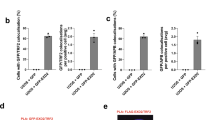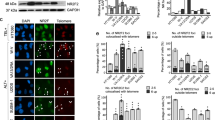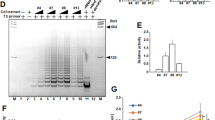Abstract
Centrosome amplification and telomere shortening, which are commonly detected in human cancers, have been implicated in the induction of chromosome instability in tumorigenesis. The functions of these two structures are closely related to DNA damage repair machinery, and some factors that operate in the maintenance of telomeres also take part in the regulation of centrosome status, suggesting they are functionally linked. We report that TEIF (telomerase transcriptional elements-interacting factor), a transactivator of the hTERT (human telomerase reverse transcriptase subunit) gene, is distributed in the centrosome throughout the cell cycle, but its transport into the centrosome is increased under some conditions, and its distribution is dependent on its C-terminal domain. Experimental modulation of TEIF expression through overexpression, polypeptide expression or depletion affected centrosome status and increased abnormalities of cell mitosis. Localization of TEIF to the centrosome was also stimulated by treatment with genotoxic agents and experimental telomere dysfunction, accompanying centrosome amplification. Moreover, we demonstrated that the expression level of TEIF is not only closely correlated with centrosome amplification in soft tissue sarcomas but it is also significantly related to tumor histologic grade. Our data confirmed TEIF functions as a centrosome regulator. Its participation in DNA damage response, including telomere dysfunction and tumorigenesis, indicates TEIF is likely to be a factor involved in linking centrosome amplification and telomere dysfunction in cancer development.
This is a preview of subscription content, access via your institution
Access options
Subscribe to this journal
Receive 50 print issues and online access
$259.00 per year
only $5.18 per issue
Buy this article
- Purchase on Springer Link
- Instant access to full article PDF
Prices may be subject to local taxes which are calculated during checkout






Similar content being viewed by others
References
Andersen JS, Wilkinson CJ, Mayor T, Mortensen P, Nigg EA, Mann M . (2003). Proteomic characterization of the human centrosome by protein correlation profiling. Nature 426: 570–574.
Bellon M, Nicot C . (2008). Regulation of telomerase and telomeres: human tumor viruses take control. J Natl Cancer Inst 100: 98–108.
Brinkley BR . (2001). Managing the centrosome numbers game: from chaos to stability in cancer cell division. Trends Cell Biol 11: 18–21.
Brown LA, Irving J, Parker R, Kim H, Press JZ, Longacre TA et al. (2006). Amplification of EMSY, a novel oncogene on 11q13, in high grade ovarian surface epithelial carcinomas. Gynecol Oncol 100: 264–270.
Chikashige Y, Tsutsumi C, Yamane M, Okamasa K, Haraguchi T, Hiraoka Y . (2006). Meiotic proteins bqt1 and bqt2 tether telomeres to form the bouquet arrangement of chromosomes. Cell 125: 59–69.
Churikov D, Wei C, Price CM . (2006). Vertebrate POT1 restricts G-overhang length and prevents activation of a telomeric DNA damage checkpoint but is dispensable for overhang protection. Mol Cell Biol 26: 6971–6982.
Dou Z, Ding X, Zereshki A, Zhang Y, Zhang J, Wang F et al. (2004). TTK kinase is essential for the centrosomal localization of TACC2. FEBS Lett 572: 51–56.
Doxsey S . (2001a). Centrosomes as command centres for cellular control. Nat Cell Biol 3: E105–E108.
Doxsey S . (2001b). Re-evaluating centrosome function. Nat Rev Mol.Cell Biol 2: 688–698.
Doxsey S, McCollum D, Theurkauf W . (2005a). Centrosomes in cellular regulation. Annu Rev Cell Dev Biol 21: 411–434.
Doxsey S, Zimmerman W, Mikule K . (2005b). Centrosome control of the cell cycle. Trends Cell Biol 15: 303–311.
Ewart-Toland A, Briassouli P, de Koning JP, Mao JH, Yuan J, Chan F et al. (2003). Identification of Stk6/STK15 as a candidate low penetrance tumor-susceptibility gene in mouse and human. Nat Genet 34: 403–412.
Fletcher L, Muschel RJ . (2006). The centrosome and the DNA damage induced checkpoint. Cancer Lett 243: 1–8.
Fukasawa K . (2005). Centrosome amplification, chromosome instability and cancer development. Cancer Lett 230: 6–19.
Gillingham AK, Munro S . (2000). The PACT domain, a conserved centrosomal targeting motif in the coiled-coil proteins AKAP450 and pericentrin. EMBO Rep 1: 524–529.
Gisselsson D . (2001). Ring chromosomes: vicious circles at the end and beginning of life. Atlas of Genetics and Cytogenetics in Oncology and Haematology. URL:http://AtlasGeneticsOncology.org/Deep/ChromosomInstabilID20023.html.
Gisselsson D . (2003). Chromosome instability in cancer: how, when, and why? Adv Cancer Res 87: 1–29.
Gisselsson D . (2005). Mitotic instability in cancer: is there method in the madness? Cell Cycle 4: 1007–1010.
Gisselsson D, Gorunova L, Höglund M, Mandahl N, Elfving P . (2004). Telomere shortening and mitotic dysfunction generate cytogenetic heterogeneity in a subgroup of renal cell carcinomas. Br J Cancer 91: 327–332.
Gisselsson D, Jonson T, Yu C, Martins C, Mandahl N, Wiegant J et al. (2002). Centrosomal abnormalities, multipolar mitoses, and chromosomal instability in head and neck tumors with dysfunctional telomeres. Br J Cancer 87: 202–207.
Gisselsson D, Lv M, Tsao SW, Man C, Jin C, Höglund M et al. (2005). Telomere-mediated mitotic disturbances in immortalized ovarian epithelial cells reproduce chromosomal losses and breakpoints from ovarian carcinoma. Genes Chromosomes Cancer 42: 22–33.
Hackett JA, Greider CW . (2002). Balancing instability: dual roles for telomerase and telomere dysfunction in tumorigenesis. Oncogene 21: 619–626.
Hara T, Matsumura-Arioka Y, Ohtani K, Nakamura M . (2008). Role of human T-cell leukemia virus type I Tax in expression of the human telomerase reverse transcriptase (hTERT) gene in human T-cells. Cancer Sci 99: 1155–1163.
Lavia P, Mileo AM, Giordano A, Paggi MG . (2003). Emerging roles of DNA tumor viruses in cell proliferation: new insights into genomic instability. Oncogene 22: 6508–6516.
Lingle WL, Salisbury JL . (2000). The role of the centrosome in the development of malignant tumors. Curr Top Dev Biol 49: 313–329.
Loffler H, Lukas J, Bartek J, Kramer A . (2006). Structure meets function—centrosomes, genome maintenance and the DNA damage response. Exp Cell Res 312: 2633–2640.
Lou Y, Xie W, Zhang DF, Yao JH, Luo ZF, Wang YZ et al. (2004). Nek2A specifies the centrosomal localization of Erk2. Biochem Biophys Res Commun 321: 495–501.
Masutomi K, Yu EY, Khurts S, Ben-Porath I, Currier JL, Metz GB et al. (2003). Telomerase maintains telomere structure in normal human cells. Cell 114: 241–253.
Matsumoto Y, Maller JL . (2004). A centrosomal localization signal in cyclin E required for Cdk2-independent S phase entry. Science 306: 885–888.
McPherson JP, Hande MP, Poonepalli A, Lemmers B, Zablocki E, Migon E . (2006). A role for Brca1 in chromosome end maintenance. Hum Mol Genet 156: 831–838.
Momotani K, Khromov AS, Miyake T, Stukenberg PT, Somlyo AV . (2008). Cep57, a multidomain protein with unique microtubule and centrosomal localization domains. Biochem J 412: 265–273.
Morris VB, Brammall J, Noble J, Reddel R . (2000). p53 localizes to the centrosomes and spindles of mitotic cells in the embryonic chick epiblast, human cell lines, and a human primary culture: an immunofluorescence study. Exp Cell Res 256: 122–130.
Ohta T, Essner R, Ryu JH, Palazzo RE, Uetake Y, Kuriyama R . (2002). Characterization of Cep135, a novel coiled-coil centrosomal protein involved in microtubule organization in mammalian cells. J Cell Biol 1561: 87–99.
Peset I, Vernos I . (2008). The TACC proteins: TACC-ling microtubule dynamics and centrosome function. Trends Cell Biol 18: 379–388.
Pihan GA, Doxsey SJ . (1999). The mitotic machinery as a source of genetic instability in cancer. Semin Cancer Biol 9: 289–302.
Plug-DeMaggio AW, Sundsvold T, Wurscher MA, Koop JI, Klingelhutz AJ, McDougall JK . (2004). Telomere erosion and chromosomal instability in cells expressing the HPV oncogene 16E6. Oncogene 23: 3561–3571.
Pumfery A, de la Fuente C, Kashanchi F . (2006). HTLV-1 Tax: centrosome amplification and cancer. Retrovirology 3: 50.
Saunders W . (2005). Centrosomal amplification and spindle multipolarity in cancer cells. Semin Cancer Biol 15: 25–32.
Slijepcevic P . (2006). The role of DNA damage response proteins at telomeres—an ‘integrative’ model. DNA Repair (Amst) 5: 1299–1306.
Smith S, de Lange T . (1999). Cell cycle dependent localization of the telomeric PARP, tankyrase, to nuclear pore complexes and centrosomes. J Cell Sci 112: 3649–3656.
Stenoien DL, Sen S, Mancini MA, Brinkley BR . (2003). Dynamic association of a tumor amplified kinase, Aurora-A, with the centrosome and mitotic spindle. Cell Motil Cytoskeleton 55: 134–146.
Tang Z, Zhang B, Xu W, Zhao Y, Hou L . (2003). Characterization of telomerase regulation-associated gene TRAP on tumor biology. J Peking Univ Health Sci 35: 402–407.
Tang Z, Zhao Y, Mei F, Yang S, Li X, Lv J et al. (2004). Molecular cloning and characterization of a human gene involved in transcriptional regulation of hTERT. Biochem Biophys Res Commun 324: 1324–1333.
van Asseldonk M, Schepens M, de Bruijn D, Janssen B, Merkx G, Geurts van Kessel A . (2000). Construction of a 350-kb sequence-ready 11q13 cosmid contig encompassing the markers D11S4933 and D11S546: mapping of 11 genes and 3 tumor-associated translocation breakpoints. Genomics 66: 35–42.
Wang X, Liu L, Montagna C, Ried T, Deng CX . (2007). Haploinsufficiency of Parp1 accelerates Brca1-associated centrosome amplification, telomere shortening, genetic instability, apoptosis, and embryonic lethality. Cell Death Differ 14: 924–931.
Wong KF . (1999). 11q13 is a cytogenetically promiscuous site in hematologic malignancies. Cancer Genet Cytogenet 113: 93–95.
Zaharieva BM, Simon R, Diener PA, Ackermann D, Maurer R, Alund G et al. (2003). High-throughput tissue microarray analysis of 11q13 gene amplification CCND1, FGF3, FGF4, EMS1 in urinary bladder cancer. J Pathol 201: 603–608.
Zhao Y, Zheng J, Ling Y, Hou L, Zhang B . (2005). Transcriptional upregulation of DNA polymerase β by telomerase transcriptional elements-interacting factor. Biochem Biophys Res Commun 333: 908–916.
Acknowledgements
This research was supported by National Natural Science Foundation of China (no. 30570691), and Doctors Program Foundations of Ministry Education (Grant 20040001147).
Author information
Authors and Affiliations
Corresponding author
Rights and permissions
About this article
Cite this article
Gong, Y., Sun, Y., McNutt, M. et al. Localization of TEIF in the centrosome and its functional association with centrosome amplification in DNA damage, telomere dysfunction and human cancers. Oncogene 28, 1549–1560 (2009). https://doi.org/10.1038/onc.2008.503
Received:
Revised:
Accepted:
Published:
Issue Date:
DOI: https://doi.org/10.1038/onc.2008.503
Keywords
This article is cited by
-
Centrosome amplification: a quantifiable cancer cell trait with prognostic value in solid malignancies
Cancer and Metastasis Reviews (2021)
-
Heading off with the herd: how cancer cells might maneuver supernumerary centrosomes for directional migration
Cancer and Metastasis Reviews (2013)



